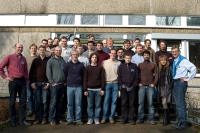 |
 |
|||||||||||||
|
|||||||||||||
|
|||||||||||||
|
When your day job means measuring the F2 structure function of the proton or hunting for the Higgs boson, you don't usually stop and wonder how exactly the ingredients of your events reached their collision point. Some 30 junior researchers have just learnt to do just this: at the recent 'Terascale Accelerator School', the first of its kind organised in Germany and a project of the Helmholtz Alliance, physics students turned into nuts-and-bolts accelerator experts for a week. The School, held at DESY, attracted 28 participants from institutes from all over Germany and beyond, with pupils ranging from physics students in their third year to post-docs. Accelerator experts gave practice-oriented talks with exercises and examples the morning and in the afternoon, the students had to solve the problems introduced during the morning session. They used the free software Scilab - a license-free version of the professional software Matlab - that only few of them had worked with before, so it was almost like learning yet another (computing) language. “They had to learn both the syntax itself and at the same time apply it to accelerator problems,” explains organiser Eckhard Elsen form DESY. “Some days they were so caught up in the challenges that they sat over the exercises well into the evening hours - some even arrived late for the official dinner.” One exercise had them calculating the behaviour of a particle train in a storage ring, where the particles had to keep a stable orbit while they turn around the ring. Another was more ILC-specific: what happens to the electron beam if you misalign the positions of the many quadrupoles by only a few micrometers? For the students, who are more used to Monte-Carlo generated particle events and parton distribution functions, this was a whole new world. One of them liked it so much that he decided to write his diploma thesis about accelerator physics now and another got attracted to the SRF cavities for his PhD thesis. The heads behind the German-wide Helmholtz Alliance network of universities and labs working on Terascale machines like the LHC and ILC will be very pleased to follow this thesis, as it ticks several boxes in the long list of the aims of the Alliance. These, apart from connecting German groups and giving them a stronger position in the international particle physics research word, include fostering young talent and making accelerator physics more prominent in university curricula. The next school, called the 'Monte Carlo School Physics at the Terascale' ticks another couple of boxes. Aimed at third-year students and up, it concentrates on physics analysis, Monte Carlo techniques and event generators and anything to do with simulation, and will also have lectures in the morning and practical exercises in the afternoon. -- Barbara Warmbein |
|||||||||||||
| © International Linear Collider |

